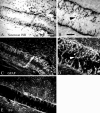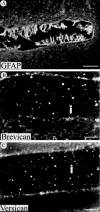The chondroitin sulfate proteoglycans neurocan and phosphacan are expressed by reactive astrocytes in the chronic CNS glial scar
- PMID: 10594061
- PMCID: PMC6784959
- DOI: 10.1523/JNEUROSCI.19-24-10778.1999
The chondroitin sulfate proteoglycans neurocan and phosphacan are expressed by reactive astrocytes in the chronic CNS glial scar
Abstract
Chondroitin sulfate proteoglycans (CS-PGs) expressed by reactive astrocytes may contribute to the axon growth-inhibitory environment of the injured CNS. The specific potentially inhibitory CS-PGs present in areas of reactive gliosis, however, have yet to be thoroughly examined. In this study, we used immunohistochemistry, combined immunohistochemistry-in situ hybridization, immunoblot analysis, and reverse transcription-PCR to examine the expression of specific CS-PGs by reactive astrocytes in an in vivo model of reactive gliosis: that is, the glial scar, after cortical injury. Neurocan and phosphacan can be localized to reactive astrocytes 30 d after CNS injury, whereas brevican and versican are not expressed in the chronic glial scar. Neurocan is also expressed by astrocytes in primary cell culture. Relative to the amount present in cultured astrocytes or uninjured cortex, neurocan expression increases significantly in the glial scar resulting from cortical injury, including the re-expression of the neonatal isoform of neurocan. In contrast, phosphacan protein levels are decreased in the glial scar compared with the uninjured brain. Because these CS-PGs are capable of inhibiting neurite outgrowth in vitro, our data suggest that phosphacan and neurocan in areas of reactive gliosis may contribute to axonal regenerative failure after CNS injury.
Figures






Similar articles
-
The chondroitin sulfate proteoglycans neurocan, brevican, phosphacan, and versican are differentially regulated following spinal cord injury.Exp Neurol. 2003 Aug;182(2):399-411. doi: 10.1016/s0014-4886(03)00087-6. Exp Neurol. 2003. PMID: 12895450
-
Changes in distribution, cell associations, and protein expression levels of NG2, neurocan, phosphacan, brevican, versican V2, and tenascin-C during acute to chronic maturation of spinal cord scar tissue.J Neurosci Res. 2003 Feb 1;71(3):427-44. doi: 10.1002/jnr.10523. J Neurosci Res. 2003. PMID: 12526031
-
Transient expression of juvenile-type neurocan by reactive astrocytes in adult rat brains injured by kainate-induced seizures as well as surgical incision.Neuroscience. 2002;112(4):773-81. doi: 10.1016/s0306-4522(02)00136-7. Neuroscience. 2002. PMID: 12088737
-
Chondroitin sulphate proteoglycans in the CNS injury response.Prog Brain Res. 2002;137:313-32. doi: 10.1016/s0079-6123(02)37024-9. Prog Brain Res. 2002. PMID: 12440375 Review.
-
Neurocan and phosphacan: two major nervous tissue-specific chondroitin sulfate proteoglycans.Perspect Dev Neurobiol. 1996;3(4):273-90. Perspect Dev Neurobiol. 1996. PMID: 9117260 Review.
Cited by
-
Arylsulfatase B improves locomotor function after mouse spinal cord injury.PLoS One. 2013;8(3):e57415. doi: 10.1371/journal.pone.0057415. Epub 2013 Mar 8. PLoS One. 2013. PMID: 23520469 Free PMC article.
-
A neural extracellular matrix-based method for in vitro hippocampal neuron culture and dopaminergic differentiation of neural stem cells.BMC Neurosci. 2013 Apr 18;14:48. doi: 10.1186/1471-2202-14-48. BMC Neurosci. 2013. PMID: 23594371 Free PMC article.
-
TGF-beta1 induction of the adenine nucleotide translocator 1 in astrocytes occurs through Smads and Sp1 transcription factors.BMC Neurosci. 2004 Jan 13;5:1. doi: 10.1186/1471-2202-5-1. BMC Neurosci. 2004. PMID: 14720305 Free PMC article.
-
Sensory deafferentation modulates and redistributes neurocan in the rat auditory brainstem.Brain Behav. 2019 Aug;9(8):e01353. doi: 10.1002/brb3.1353. Epub 2019 Jul 4. Brain Behav. 2019. PMID: 31271523 Free PMC article.
-
Neurons, Glia, Extracellular Matrix and Neurovascular Unit: A Systems Biology Approach to the Complexity of Synaptic Plasticity in Health and Disease.Int J Mol Sci. 2020 Feb 24;21(4):1539. doi: 10.3390/ijms21041539. Int J Mol Sci. 2020. PMID: 32102370 Free PMC article. Review.
References
-
- Ascher RA, Fidler PS, Rogers JH, Fawcett JW. TGF-β stimulates neurocan synthesis in cultured rat astrocytes. Soc Neurosci Abstr. 1998;24:56.
-
- Bovolenta P, Wandosell F, Nieto-Sampedro M. Characterization of a neurite outgrowth inhibitor expressed after CNS injury. Eur J Neurosci. 1993;5:454–465. - PubMed
-
- Bovolenta P, Fernaud-Espinosa I, Méndez-Otero R, Nieto-Sampedro M. Neurite outgrowth inhibitor of gliotic brain tissue. Mode of action and cellular localization, studied with specific monoclonal antibodies. Eur J Neurosci. 1997;9:977–989. - PubMed
Publication types
MeSH terms
Substances
Grants and funding
LinkOut - more resources
Full Text Sources
Other Literature Sources
Medical
Miscellaneous
